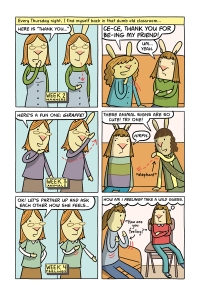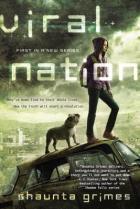To wrap up our anniversary month, here’s an article about the importance of letting people speak for themselves–an important guideline here at Disability in Kidlit–written by author Lyn Miller-Lachmann. To make things even more exciting, we’re giving away a signed hardcover of Lyn’s book Rogue! Details at the end of the post.
 Lyn Miller-Lachmann is the former editor-in-chief of MultiCultural Review and the author of resources for educators and fiction for teens. Her young adult novel Gringolandia (Curbstone Press/Northwestern University Press, 2009), about a teenage refugee from Chile coming to terms with his father’s imprisonment and torture under the Pinochet dictatorship, was a 2010 ALA Best Book for Young Adults and received an Américas Award Honorable Mention from the Consortium of Latin American Studies Programs. Its forthcoming companion, Surviving Santiago (Running Press, 2015), portrays a 16-year-old girl’s journey to Chile to visit her estranged father and her dangerous romance with a local boy. Lyn is the author of Rogue (Penguin/Nancy Paulsen Books, 2013), a Junior Library Guild selection about a girl with undiagnosed Asperger’s syndrome and an X-Men obsession, in search of a friend and her own special power. When she isn’t writing fiction, Lyn is the co-host of a bilingual program of Latin American and Spanish music, poetry, and history on WRPI-FM, a blogger, and a Lego builder. She reviews children’s and young adult books on social justice themes for The Pirate Tree. For more information and cool Lego pictures, visit Lyn’s website.
Lyn Miller-Lachmann is the former editor-in-chief of MultiCultural Review and the author of resources for educators and fiction for teens. Her young adult novel Gringolandia (Curbstone Press/Northwestern University Press, 2009), about a teenage refugee from Chile coming to terms with his father’s imprisonment and torture under the Pinochet dictatorship, was a 2010 ALA Best Book for Young Adults and received an Américas Award Honorable Mention from the Consortium of Latin American Studies Programs. Its forthcoming companion, Surviving Santiago (Running Press, 2015), portrays a 16-year-old girl’s journey to Chile to visit her estranged father and her dangerous romance with a local boy. Lyn is the author of Rogue (Penguin/Nancy Paulsen Books, 2013), a Junior Library Guild selection about a girl with undiagnosed Asperger’s syndrome and an X-Men obsession, in search of a friend and her own special power. When she isn’t writing fiction, Lyn is the co-host of a bilingual program of Latin American and Spanish music, poetry, and history on WRPI-FM, a blogger, and a Lego builder. She reviews children’s and young adult books on social justice themes for The Pirate Tree. For more information and cool Lego pictures, visit Lyn’s website.
People with disabilities often encounter situations where we are not allowed to speak for ourselves. For instance, restaurant servers may ask a companion what a person in a wheelchair, or with a visual or hearing impairment, would like to eat, rather than asking the person directly. This is just one example of what people with disabilities, people of color, and other marginalized peoples encounter on a regular basis. Due to their privilege, some people believe they have the right not only to speak for those of us on the margins, but also to depict and define us. And when privileged outsiders define us, they often do so out of ignorance, self-interest, or malice, and their versions of ourselves, rather than our own realities, become the norm.
As someone diagnosed with Asperger syndrome, I have experienced this first-hand. Over the past decade, books and other media depictions of people on the autism spectrum have proliferated. While Temple Grandin and John Elder Robison, both diagnosed on the autism spectrum, have published acclaimed memoirs for adult readers, fiction for children and teens with protagonists and major secondary characters on the spectrum is predominantly the work of outsiders. (I would consider neurotypical parents of children on the spectrum to occupy an in-between position, but one with its own baggage.)
I approach each new book written by outsiders with trepidation. These books tend to define us by our disabilities rather than showing us living our lives day-to-day. Because I wasn’t diagnosed until adulthood—the Asperger’s diagnosis didn’t exist in my youth—I thought of myself as someone who had different interests from my peers and few friends as a result, but I was not a compilation of stereotypical traits. Nor was learning to accept my difference my core desire. (My desire as a teenager was to get into a prestigious college and leave the narrow, conservative community where I grew up.) Outsiders who haven’t lived the life but who base their stories on book research are especially vulnerable to writing characters defined by their disabilities.
Problematic portrayals of children and teens with autism written by outsiders (and baggage-laden parents) have won major awards and become the canon, often helped by their writers’ superior publicity and marketing skills. As part of the canon, these books determine how teachers and librarians view their students on the spectrum and what those students may or may not be capable of accomplishing. These books affect the image young people on the spectrum have of themselves. Some portrayals that I have read have left me feeling humiliated—such as when a fictional child similar to me spends two days trying to cut down a huge oak tree with a coin because she takes something too literally. I know what classmates not on the spectrum would have said to me had they read that scene in class. (It would have involved the “r-word.”) In this way, exaggerated and stereotyped portrayals meant to combat bullying make the bullying worse. Always portraying children and teens with Asperger’s taking everything literally (contrary to popular portrayals, we usually do figure out idioms pretty quickly) invites cruel pranks, which I have suffered as much in our supposedly enlightened and aware times as when I was growing up. Finally, when outsiders’ inauthentic and insensitive depictions are lauded as authentic and sensitive, the stories I tell, even if based on my own life, are seen as inauthentic if they fail to conform to the canon. I watch helplessly as my experiences and feelings are denied, and my truth is no longer the truth. I have essentially been defined by others—as have my characters on the spectrum.
Do cultural outsiders have the “right to write” about us? Only if they are genuine allies, have done their homework, ask us to vet their work—and act to increase opportunities for us to tell our own stories. If you are writing a book that features a major character with Asperger’s, I would appreciate your listening to me and telling your story with thoughtfulness and humility. I would also appreciate your support as I try to find my own place as a writer.
Kiara has Asperger’s syndrome, and it’s hard for her to make friends. So whenever her world doesn’t make sense—which is often—she relies on Mr. Internet for answers. But there are some questions he can’t answer, like why she always gets into trouble, and how do kids with Asperger’s syndrome make friends? Kiara has a difficult time with other kids. They taunt her and she fights back. Now she’s been kicked out of school. She wishes she could be like her hero Rogue—a misunderstood X-Men mutant who used to hurt anyone she touched until she learned how to control her special power.
When Chad moves in across the street, Kiara hopes that, for once, she’ll be able to make friendship stick. When she learns his secret, she’s so determined to keep Chad as a friend that she agrees not to tell. But being a true friend is more complicated than Mr. Internet could ever explain, and it might be just the thing that leads Kiara to find her own special power.
Lyn has generously donated a signed–and if desired, personalized–hardcover of Rogue be given to one of our followers. To enter, simply leave a comment here on WordPress or reblog our Tumblr post. (Yes, doing both increases your chances!) In one week, we’ll select a single winner from one of these locations to win the book. This giveaway is limited to North American addresses.
The winner has been selected, and the giveaway is over. Thanks for participating!


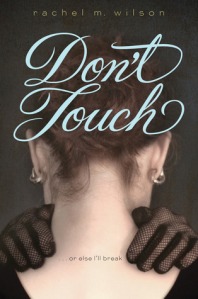
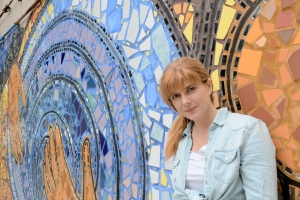






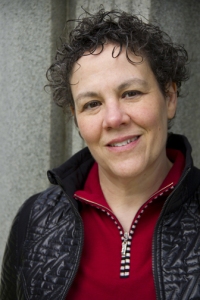



 Alyson Beecher is currently a Literacy Specialist for the Pasadena Unified School District, and the Chair for the 2015 Schneider Family Book Award Jury. After volunteering in high school as a peer tutor for students with special needs, she decided to become a Special Education Teacher. On her road to becoming a teacher, she spent two years as one of the few hearing students at Gallaudet University, the world’s only university for the deaf and hearing impaired. She has been a Special Education Inclusion Teacher, and an administrator of Special Education Programs. She loves to read and talk about books, and match students with the perfect book. Alyson blogs at
Alyson Beecher is currently a Literacy Specialist for the Pasadena Unified School District, and the Chair for the 2015 Schneider Family Book Award Jury. After volunteering in high school as a peer tutor for students with special needs, she decided to become a Special Education Teacher. On her road to becoming a teacher, she spent two years as one of the few hearing students at Gallaudet University, the world’s only university for the deaf and hearing impaired. She has been a Special Education Inclusion Teacher, and an administrator of Special Education Programs. She loves to read and talk about books, and match students with the perfect book. Alyson blogs at 




